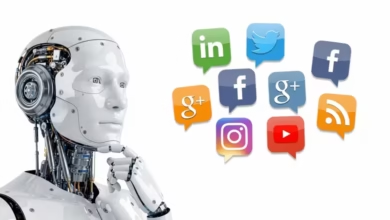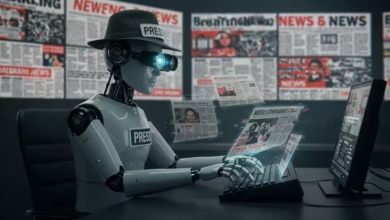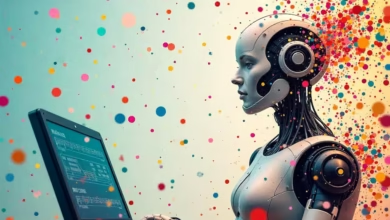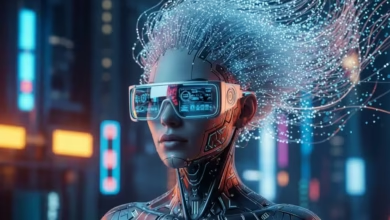Generative Creativity in Art and Media

Have you noticed lately how some pieces of digital art or media feel less like someone’s inner vision and more like something an algorithm dreamed up? That’s not a bad thing—it’s what generative creativity in art and media is all about. In 2025, artificial intelligence isn’t just assisting artists and content creators—it’s becoming an integral co-creator in many fields, from visual arts and music to film and publishing. But this rise comes with both dazzling possibilities and hard questions: What counts as genuine creativity? Who owns AI-made art? What ethical responsibilities do we have?
What Is Generative Creativity?
- Definition & Scope: Generative creativity refers to works produced with the help of AI models that generate new content—images, sounds, text, video—often based on patterns they’ve learned from existing data. This can mean fully AI-generated content, or hybrid works combining human and AI contributions.
- Tools & Mediums: Some artists use AI generative image models (e.g. Midjourney, DALL-E, Stable Diffusion), AI music prompts, video synthesis tools, or augmentation tools that add AI-assisted elements to traditional art or media.
- Production vs Creative Vision: A key tension is between speed/scale (how fast AI can create) and depth/vision (what human artists bring in terms of intentionality, emotional nuance, cultural meaning).
Trends in 2025
- Style Blending & Personal Aesthetic Signatures
Artists are increasingly training or fine-tuning models to reflect their unique styles—brush strokes, color palettes, themes—rather than relying on generic AI outputs. This personalization helps differentiate work and preserve artistic voice. maleexpressions.com - Cross-Cultural and Hybrid Art Forms
We’re seeing more fusion between local cultural motifs and global digital styles. Generative AI allows easier incorporation of motifs from non-Western aesthetics, indigenous artistic forms, or historical art styles in new pieces. This hybridization raises both creative richness and ethical concerns about appropriation. ArtMajeur Online Art Gallery - Interactive & Dynamic Media
AI-driven art that changes in response to viewer input (movement, time, data) or that evolves over time is growing. Examples include generative installations, live visuals, real-time music visuals, or video art with generative effects. Toxigon - Institutional Acceptance & Market Growth
Major galleries, auction houses, and collectors are taking AI art more seriously. Some AI-generated works are being exhibited, sold, and collected, signaling maturation in the market. guidosalimbeni.it
Challenges, Ethical & Legal Issues
- Originality & Authorship
Many artworks generated by AI are based on training with datasets that include many human artists’ works. This raises questions about whether these AI outputs are truly original, or derivative. Who qualifies as the author—the user, the model designer, or both? manuelgarcia.info - Copyright and Ownership
Laws in many jurisdictions still require a human creator for copyright protection. Pure AI-generated works without sufficient human input may not qualify. There are ongoing lawsuits and policy debates about what counts as sufficient human contribution. OECD - Economic Impact on Artistic Labor
As generative AI can produce images or media at scale and low cost, there’s a risk of undervaluing human artists, reducing opportunities, or saturating the market with content. Many creators report that clients prefer cheaper AI-assisted work, undermining livelihoods. entrepreneurs.hk - Bias, Representation & Cultural Sensitivity
Training datasets often overrepresent certain styles, regions, or demographics, leading to cultural biases or erasure of underrepresented voices. Also, using cultural motifs without proper attribution or understanding can lead to misrepresentation. manuelgarcia.info - Quality and Consistency Issues
Even advanced AI has limitations—artifacts, inconsistent details (hands, facial features, perspective), visuals that fail to convey depth or narrative coherence. For many professional artists, achieving a stable realization of a creative vision via AI remains challenging. Digest by The HEAD Foundation
Positive Impacts & Opportunities
- Democratization of Creativity
AI tools lower entry barriers: people without formal training can experiment, create, share. This expansion can lead to surprising innovation. - New Forms of Expression
Generative art enables art forms that were difficult or expensive before: large-scale interactive installations, immersive digital experiences, multi-modal art (audio-visual text combined). - Efficiency & Creative Support
Artists can use AI to iterate more quickly, test many ideas, and offload repetitive tasks (backgrounds, color corrections, etc.), leaving more time for high-level creative thinking. - Curation, Archiving, Digital Arts Spaces
AI aids in organizing large image/video archives, discovering visual similarities, recommending works to audiences. New spaces like AI art museums or galleries focused on digital/AI art are emerging. Example: Dataland in Los Angeles is planned as the first AI arts museum. Wikipedia
What Needs to Be Done: Toward Ethical & Sustainable AI-Art Futures
- Transparent Training Data & Attribution
Ensure artists know if their works are used for training. Implement systems for attribution and compensation. - Regulatory & Copyright Reform
Laws must clarify what counts as human authorship, define legal protection for hybrid works, and regulate fair use of training data. - Support for Artists’ Livelihoods
Platforms should offer fair remuneration models. Consider certification or labels marking human-AI collaborative works vs pure AI. - Cultural Sensitivity & Diversity
Be mindful when using motifs or styles from cultures. Involve creators from those cultures. Avoid appropriation. - Quality, Authenticity & Narrative Depth
Encourage tools that allow fine control, correction of AI’s shortcomings. Support artist education for using these tools well.
Real-World Examples
- Algorithm King by Ai-Da — a humanoid robot artist painting a likeness of King Charles III. A striking example of how the boundary between machine and artist is being interrogated. Wikipedia
- Eco-conscious & Sustainable AI Art Trends — more artists using recycled/digital materials, low-impact methods, themes of climate activism, environmental consciousness in their content. ArtMajeur Online Art Gallery
- Exhibition Spaces Exploring Human-Nonhuman Boundaries — shows like Inanimate in London explore how emotional attachment, embodiment, and technology intersect in AI art and digital media. Wikipedia
AI’s role in art, creativity & media is not just expanding—it’s transforming what art can be, how it’s made, who makes it, and how audiences relate. Generative creativity in art and media opens doors to incredible new expressive possibilities, but also surfaces messy questions about authorship, ethics, economic justice, and authenticity.
As we enjoy the new horizons AI offers, we need to keep asking: Is faster better? Is scale at the expense of soul? Because preserving what makes art human—vision, intent, emotion—matters deeply. We must ensure that as AI tools grow more powerful, the voices, values, and rights of artists remain central.
For similar articles, please visit: AI in Art, Creativity & Media
Homepage / humanaifuture.com




